When you sell a product or service, it’s inevitable that your customers will need assistance at some point.
Customer service greatly depends on the use of support tickets.
It is known that the global implementation of the support ticket has significantly transformed customer support workflow processes by ensuring faster resolution of customer issues.
Hence, providing a satisfying solution not only secures the loyalty of an individual but also potentially yields positive reviews they may share with others.
Definition of support ticket
A support ticket is a sort of interaction between a customer and a support team.
When customers encounter problems or difficulties that require the attention of the support teams, they create tickets, and the teams then communicate by replying to the tickets.
Numerous support tickets are collected, sorted, and managed from different channels within a ticketing system.
Every ticket created has its unique ticket ID number which makes it easy for the support team to track the status of each ticket.
This ensures that no ticket gets omitted and makes it easy to search for and find specific interactions based on priorities.
For support tickets, a notification email is sent to the respective customer whenever there is any progress or a status change.
Immediately after the ticket has been resolved, the status is then changed to closed by the support teams.
What is a support ticket system?
Support ticket systems are centralized platforms that store, organize, and manage incoming tickets to categorize and tag issues.
Regardless of various channels of communication, such as customer portals, social media, email, community forums, and web forms, customer issues or inquiries are automatically converted to tickets to better track and prioritize customer requests efficiently.
This system automatically routes or assigns customer support tickets to the right support teams or groups by using a round-robin logic, sending all company customer interactions to the same shared inbox.
As a result, companies can consolidate ticket requests from all these channels on a single dashboard, thanks to this multi-channel approach.
This enables support teams to address the most urgent issues and reduce response times, ultimately leading to customer satisfaction.
Struggling to Manage Your Customer Requests?
Are customer inquiries piling up? Take control and transform your support with our advanced ticketing system today!
Where do customer support tickets come from?
Customer support tickets originate from various communication channels where customers interact with businesses to seek assistance or report issues.
These channels include
- Email: Customers send inquiries or complaints directly to a support email address, which are then converted into tickets.
- Live chat: Online chat interactions with customers on websites or apps are often captured as tickets for follow-up.
- Social media: Messages or posts from platforms like X, Facebook, WhatsApp, or Instagram are integrated into ticketing systems to address public or private concerns.
- Customer portals: Self-service portals allow users to submit tickets directly through forms or help center interfaces.
- Phone calls: In order to keep track of the concerns discussed, customer service representatives may create tickets in response to calls.
- Mobile apps: In-app support features can allow customers to submit tickets directly from their mobile devices.
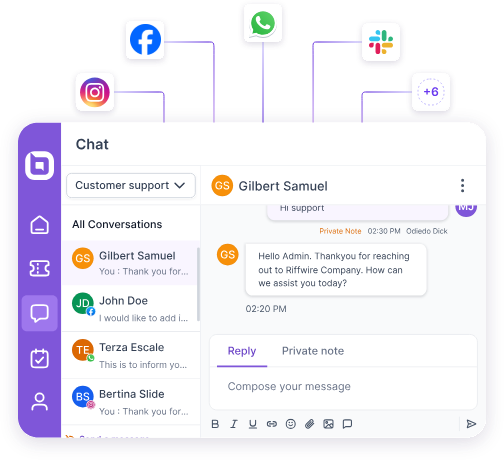
No matter the source, omnichannel ticketing enables companies to manage consumer interactions with ease, ensuring dependable service and effective operations.
By combining all channel tickets onto one platform, companies can make sure
- Every query is monitored and accounted for, so no ticket is ever overlooked.
- Teams won’t need to log into each individual channel to access or track tickets, saving time and effort.
- Enhanced collaboration and escalation, as agents can seamlessly work together to resolve issues without channel-specific barriers.
Types of support tickets
A support ticket can be categorized into various types, each serving a distinct purpose and addressing specific customer needs.
Some of the types are listed below
High-priority ticket
A high priority ticket is an urgent customer request or issue that is believed to be of utmost importance and needs immediate attention and resolution.
These tickets are assigned a higher level of urgency and are typically given precedence over other tasks or issues to ensure timely and efficient resolution.
It often indicates that the customer might face a major disruption, critical business impact, or severe technical difficulty that affects their ability to use a product or service effectively.
Considering this, users generate tickets from a centralized system based on the level of priority, such as Critical, High, Normal, or Low.
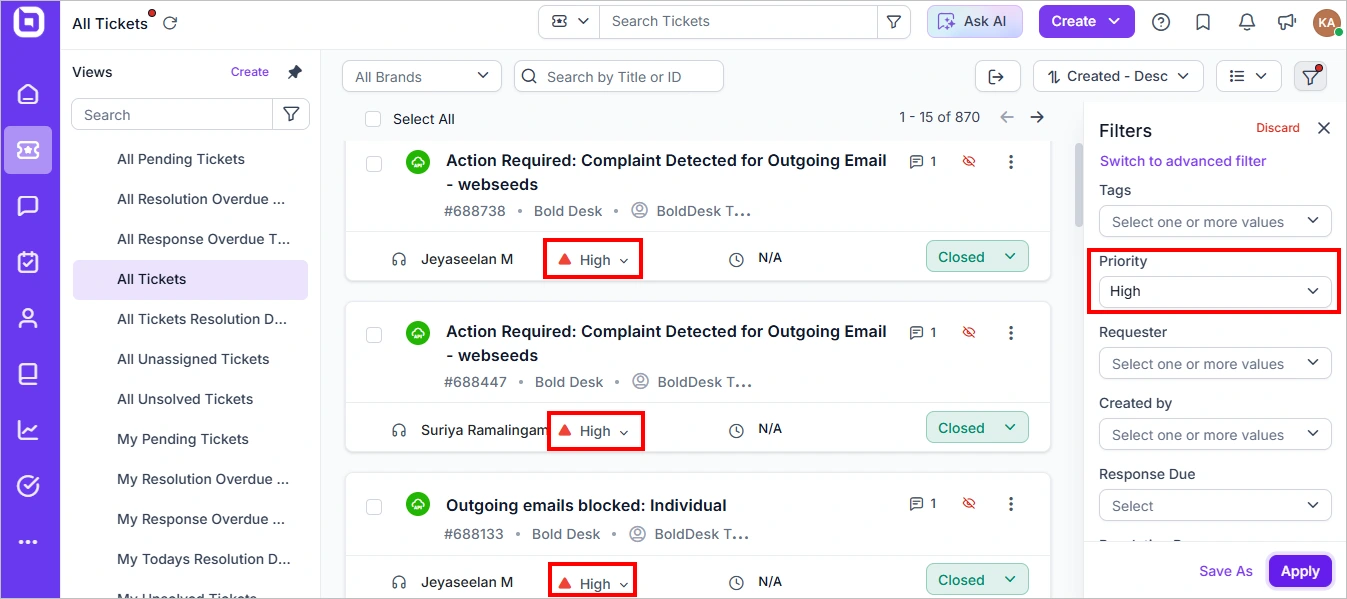
These aids in
- Prioritize ticket resolution
- Speed up resolution
- Ensure customer satisfaction
- Maintain a positive customer experience
Open ticket
An open support ticket refers to a customer inquiry or issue that has been logged but remains unresolved or pending any action.
Every incoming ticket to the help desk inbox is automatically marked as Open.
When a customer support ticket is still in an open state, it indicates that no correspondence has yet been attempted with the customer, and their query remains unanswered.

It is essential to assign open tickets to appropriate agents promptly to advance ticket resolution.
Closed or resolved ticket
A closed or resolved ticket signifies that the problem has been resolved and does not necessitate any further action.
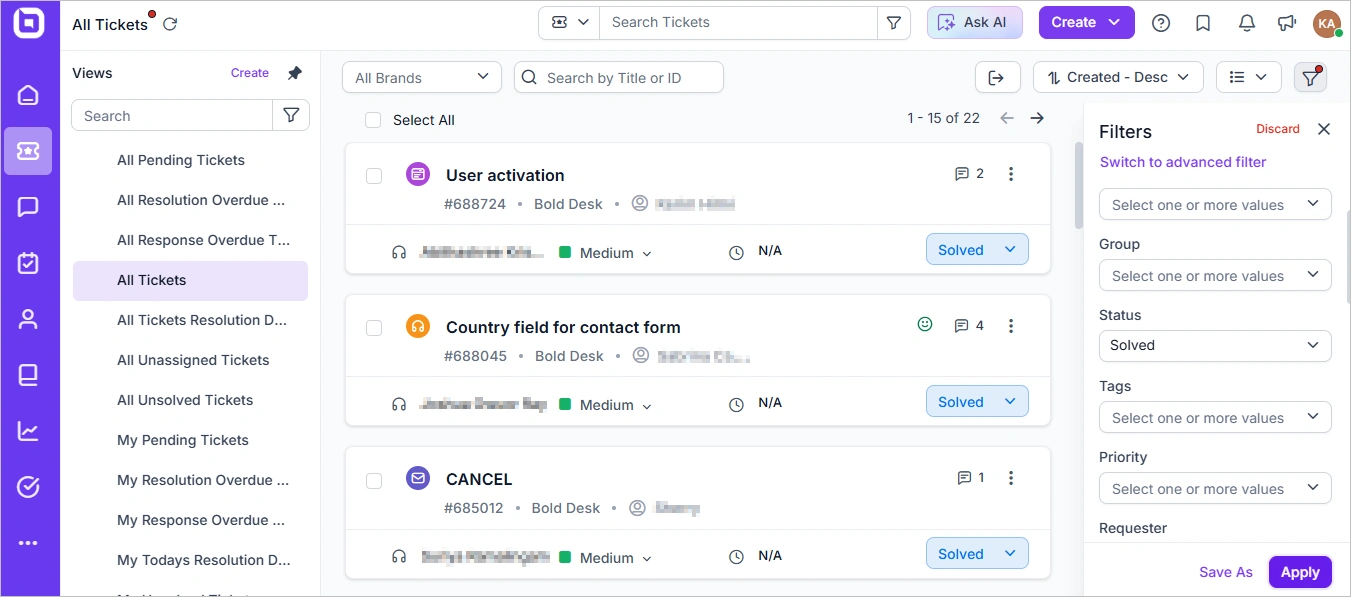
The closed ticket serves as a record of the reported issue and the support provided, enabling tracking and analysis of support activities.
Reopened ticket
A reopened ticket occurs automatically when an end-user responds to a closed ticket.
The support ticket will automatically be reopened for further investigation and resolution.
This status indicates that the issue had not been fully resolved or the customer is not satisfied with the information provided in previous interactions and requires additional attention.
Reopening the ticket ensures the originally assigned agent addresses the customer’s needs to their satisfaction and ensures a positive experience.
Escalated ticket
An escalated ticket refers to a situation where a customer support request has been assigned to a higher level of authority or expertise within an organization, perhaps due to failure to resolve the ticket on time.
An escalation process ensures that all issues receive the necessary attention and resources to be resolved in a timely manner.
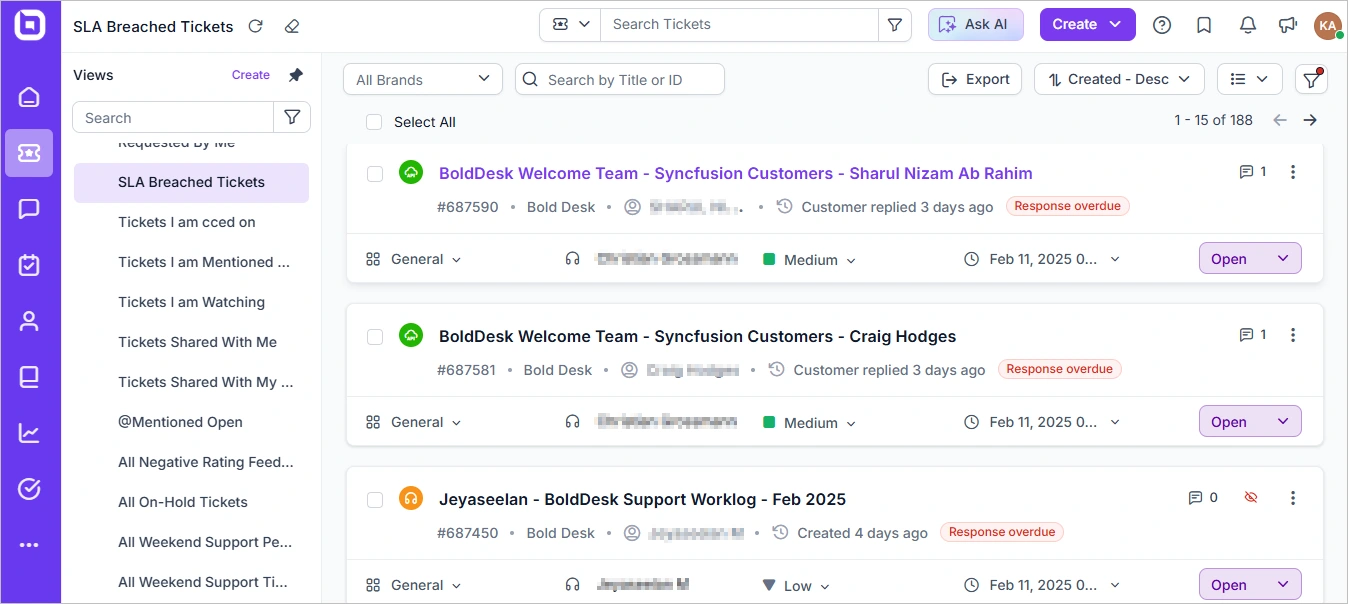
If a ticket is not responded to or resolved by the support team before the SLA-mandated response deadlines, the SLA is breached.
A ticketing system creates a ticket escalation and sends it to a manager.
In such cases, the manager will increase the priority and assign the ticket to a more experienced agent or request the already-assigned agent work on the issue immediately, to prevent further escalation.
The major elements of a customer service ticket
A support ticket consists of four primary components:
Description of customer’s issue
This component includes the details of the customer’s problem or request.
Agents use this description to decide how to handle the specific ticket, determine its priority level, and identify the department responsible for this kind of issue.
It’s best to encourage detailed descriptions so that the customers’ issues are comprehensively understood and resolved effectively.
Here, attachments can be added for further explanation, as well.
Customer’s relevant information
This component comprises a customer’s name, contact details, email address, and other personal identification data.
Having these fields properly filled out maintains a comprehensive record of the customer’s history and facilitates future reference if required.
The priority level
Ticket priority classification is crucial in determining the order in which tickets are addressed by the support team.
Therefore, during ticket creation, customers can set tickets as critical, high, low, or normal priority depending on the problem.
By categorizing the urgency of the problem based on its impact on the customer’s operations, support teams effectively ensure that critical issues receive prompt attention.
They can thereby minimize any disruption to the customer’s workflow.
Ticket number
As previously stated, every ticket possesses a unique number, which helps agents manage and track tickets during the entire resolution process.
Implementing ticketing software can greatly enhance the management and organization of support tickets, making sure that none are ignored or left unresolved.
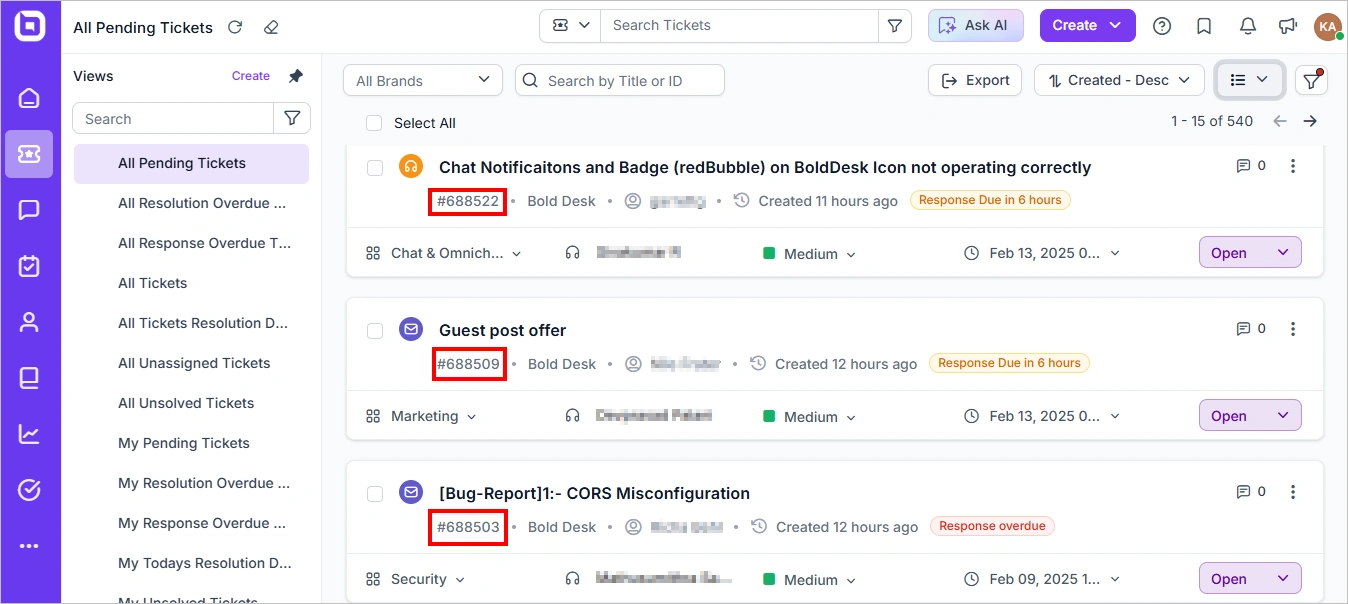
A ticketing system ensures that customers are regularly informed about the progress of their requests and that all tickets are promptly resolved.
Benefits of support ticketing in customer service
The advantages of utilizing support ticketing systems in customer service interactions are numerous and noteworthy:
Provides a streamlined customer communication platform
Support tickets offer support teams a structured and efficient way to communicate with customers about their issues, requests, and concerns.
Whether this communication takes place through social media, your website, community forums, or email, a ticket is created and information requested of the customer.
This structured approach ensures that all issues are handled and relevant information acquired, allowing the support team to better understand and address their problems.
Helps manage and prioritize customer inquiries
A customer service ticket enables businesses to manage and prioritize customer inquiries.
Managing customer inquiries involves capturing all incoming queries through various channels.
This is essential in ensuring that no customer inquiry goes unnoticed or unresolved.
By assigning priority levels to each ticket, organizations can allocate their support effectively and ensure that urgent matters are addressed quickly.
This helps streamline the support workflow and manage customer inquiries.
Support team collaboration
By centralizing customer inquiries in a ticketing system, support agents can easily share information through their shared inboxes and collaborate on resolving complex issues.
Enhanced knowledge sharing and streamlined ticket resolution processes through features like private notes, private tickets, tags, watchers, and CCs, improving interaction among employees.
Better tracking of issues and resolutions
Support tickets enable businesses to analyze and identify recurring issues or patterns in inquiries.
Businesses can identify common customer pain points by using key performance indicators (KPIs) in support-monitoring dashboards and implement measures to address those points.
Making changes based on support data not only helps in reducing the number of support tickets submitted but can also enhance the overall product or service quality, leading to increased customer satisfaction and loyalty.
Tips to resolve support tickets faster
To speed up the resolution of support tickets and enhance customer satisfaction, it is crucial to implement effective strategies.
Here are eight tips that can assist in resolving support tickets more efficiently.
1. Implement a support ticketing system
Utilizing a robust issue ticketing system can streamline the resolution process by providing an organized and centralized platform for support agents to monitor the status and progress of each support ticket.
By implementing such a system, organizations can promptly identify and address any bottlenecks or delays and improve customer satisfaction.
Other benefits include:
- Enables customers to easily submit their requests or concerns through various channels such as email, phone, or online forms.
- Facilitates effective communication between customers and support teams.
- Enables businesses to analyze and evaluate their support performance.
2. Prioritize tickets based on their level of urgency
Focusing on tickets based on urgency is essential for efficient ticket management.
Support teams should adopt a systematic approach to prioritizing tickets, categorizing them based on factors such as customer-set priority level, severity, customer importance, and potential business impact.
This enables support agents to allocate their time and resources effectively, ensuring that critical issues are addressed promptly while still providing adequate attention to less urgent matters.
3. Enhance communication channels
Providing multiple communication channels through which customers can reach out for support can significantly advance customer satisfaction.
An omnichannel inbox allows customers to reach out through various channels—such as email, phone, social media, and live chat—ensuring they can choose the method that is most convenient for them.
Since all these interactions are brought together in one centralized system, it becomes easier for support teams to monitor and attend to customer queries.
Using omnichannel solutions also provides agents with adequate background information about the issue at hand, as the customer’s previous interactions will be accessible in the same place.
4. Utilize self-service options
Implementing a self-service portal can empower customers to resolve their issues independently.
By offering a comprehensive knowledge base with FAQs, company policies, how-to guides, and tutorial videos about company products and services, companies let customers resolve common problems without needing to create a support ticket.
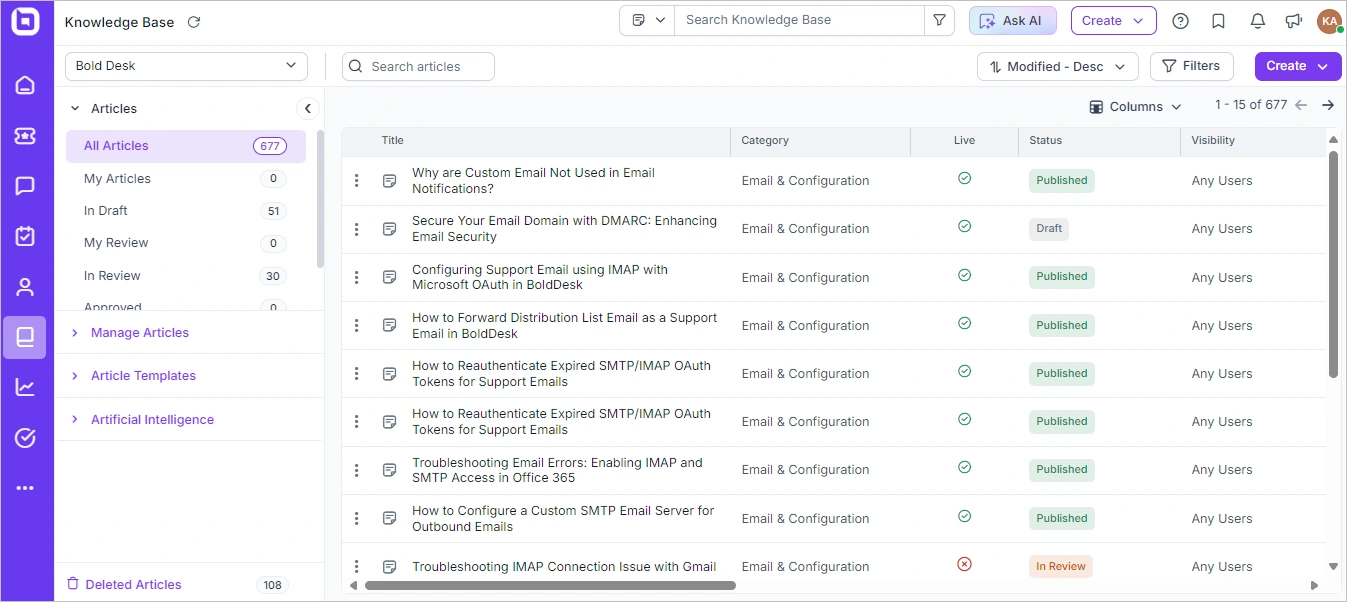
This not only decreases the number of support tickets but also speeds up the resolution of more complex issues. It’s a win-win for your team and customers.
5. Create service-level agreements (SLAs)
A service-level agreement is consent established between a service provider and a customer, outlining the specific levels of service, performance, and responsibilities expected from both parties.
For support, SLAs define the expected response and resolution times for different types of tickets, enabling support teams to prioritize their efforts accordingly.
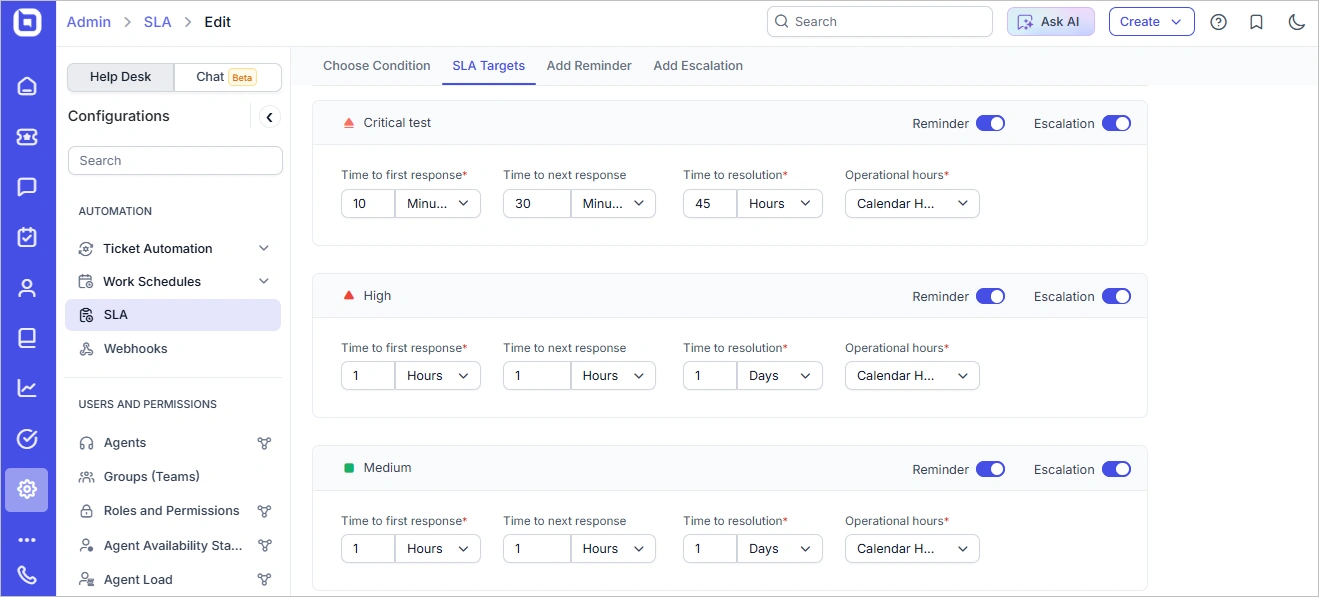
By setting realistic and achievable SLAs and incorporating them into their ticketing system, businesses can effectively manage customer expectations, promote transparency, and ensure a consistent level of customer service delivery.
6. Foster collaboration among support teams
A survey from uSamp Research on behalf of Ringtone showed that 97% of business respondents affirmed that communication has a daily impact on tasks.
Encouraging collaboration among support agents and departments is vital for resolving tickets faster.
The shared knowledge base can help with this, as well as the utilization of collaboration tools and a clear hierarchy for who attends to which kinds of issues.
This enables agents to access relevant information, share insights, and collaborate on challenging issues.
A collective problem-solving approach ultimately leading to quicker ticket resolution and better overall support team productivity.
7. Continuously monitor metrics and improve
Leveraging data and analytics is key to optimizing ticket management processes.
Companies should regularly track support metrics and customer feedback to analyze metrics like:
- Response times
- Resolution rates
- Customer satisfaction scores
Analyzing ticket trends helps businesses identify common issues, recurring patterns, and areas for improvement.
Commitment to ongoing evaluation and improvement enhances customer satisfaction.
8. Train your support teams regularly
Regular training sessions and performance evaluations can enhance the skills and knowledge of support agents, enabling them to handle support tickets more efficiently.
They also give agents more confidence and independence in their work.
By staying updated with the latest industry trends and best practices, support agents can provide faster and more accurate resolutions, resulting in improved customer satisfaction.
9. Offer real-time support through live chat
Offering real-time support through live chat can significantly enhance response times. Live chat allows customers to engage with support representatives instantly, reducing wait times and improving overall satisfaction.
This immediate access to assistance enables agents to clarify issues quickly, provide timely solutions, and close tickets more efficiently.
Customer service made better with support tickets
Support tickets and ticketing systems are essential components of modern support practices.
If tickets are not properly managed, a huge volume of customer inquiries could be overwhelming for even the most experienced support teams.
Therefore, it is imperative to enhance communication within the company, monitor ticket progress, and analyze metrics that aid in improving the customer experience and resolving issues promptly.
BoldDesk will help you enhance your service quality with an excellent, full-featured support ticketing system. Contact our support team for any inquiries and see how BoldDesk can be customized for your business needs.
Related articles
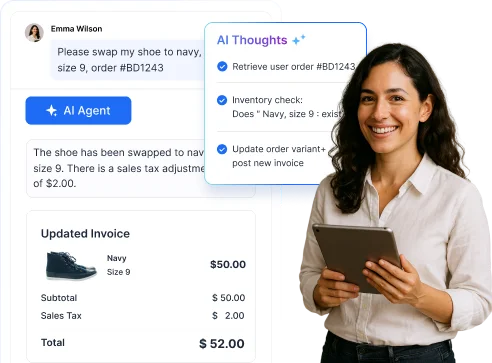


















 Email Ticketing System
Email Ticketing System Shared Inbox Software
Shared Inbox Software Multi Brand Help Desk
Multi Brand Help Desk Internal Help Desk Software
Internal Help Desk Software Trouble Ticketing Software
Trouble Ticketing Software Mobile Help Desk
Mobile Help Desk 















